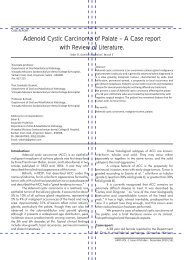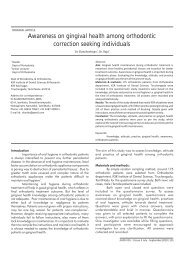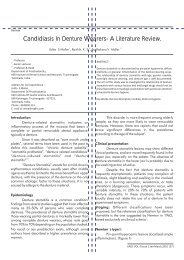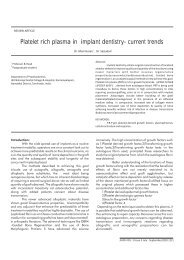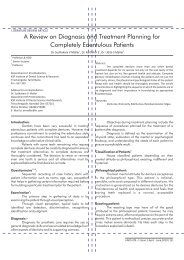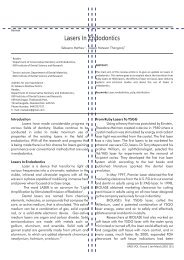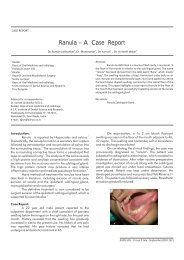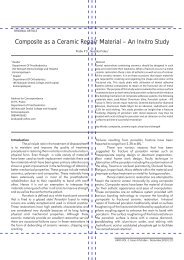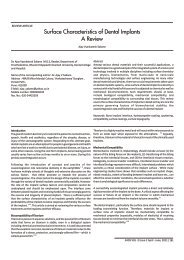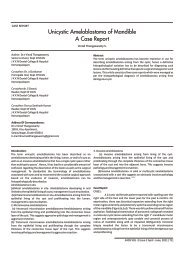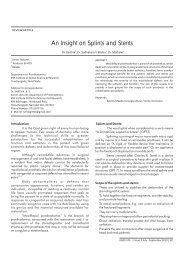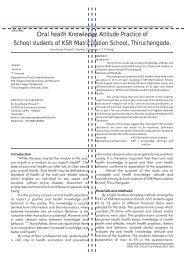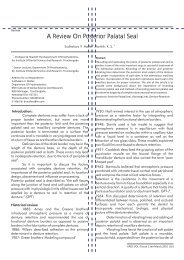Enterococcus faecalis -An Endodontic Challenge
Enterococcus faecalis -An Endodontic Challenge
Enterococcus faecalis -An Endodontic Challenge
You also want an ePaper? Increase the reach of your titles
YUMPU automatically turns print PDFs into web optimized ePapers that Google loves.
MTAD (a mixture of tetracycline isomer,acid<br />
and detergent):MTAD is a formulation of<br />
doxycycline, citric acid and Tween 80. Its<br />
effectiveness is attributed to its anticollagenase<br />
activity, low pH and ability to be gradually<br />
released overtime. Mahmoud Torabinejad et al<br />
observed that MTAD is effective against<br />
E.<strong>faecalis</strong> . 7 MTAD is beneficial for retreatment<br />
cases as well.<br />
In one study a combination of calcium<br />
hyrdroxide and camphorated<br />
paramonochlorophenol completely eliminated<br />
E.<strong>faecalis</strong>.Metapex (a silicone oil-based calcium<br />
hydroxide paste containing 38% iodoform),<br />
more effectively disinfected dentinal tubules<br />
infected with E.<strong>faecalis</strong> than calcium hydroxide<br />
alone. 2% chlorhexidine gel when combined<br />
with calcium hydroxide achieves a pH of 12.8<br />
and can completely eliminate E.<strong>faecalis</strong> within<br />
dentinal tubules. Chlorhexidine and calcium<br />
hydroxide when combined together have<br />
shown better antimicrobial properties than<br />
calcium hydroxide alone. 8<br />
Nair, et al suggested the need of non antibiotic<br />
chemomechanical measures to treat teeth with<br />
infected and necrotic root canals so as to<br />
disrupt the biofilm.<br />
Er:Cr:YSGG laser employing radially emitting<br />
laser tips demonstrated a considerable effect<br />
on bacterial reduction within dentinal tubules<br />
of root canal infected with E.<strong>faecalis</strong>. 9<br />
Roth 811 sealer ,a zinc –oxide eugenol based<br />
sealer has been shown to exert antibacterial<br />
activity against E.<strong>faecalis</strong>.AH Plus (epoxy resin<br />
based sealer) and Grossman’s sealer are<br />
effective in killing E.<strong>faecalis</strong> within infected<br />
dentinal tubules.<br />
Steps that can be considered towards the<br />
elimination and prevention of E.<strong>faecalis</strong>:<br />
Treatment regimens should aim at prevention<br />
and elimination of E.<strong>faecalis</strong> during treatment,<br />
inbetween appointments and after completion<br />
of treatment. We can prevent its re-entry by<br />
following certain norms. That includes,<br />
ensuring that the patient rinses with 0 .2%<br />
chlorhexidine prior to the treatment,<br />
disinfecting the tooth and rubber dam with<br />
chlorhexidine or sodium hypochlorite and<br />
disinfecting gutta-percha points with sodium<br />
hypochlorite before insertion in the canal.<br />
Besides the above norms the following can be<br />
followed:<br />
1. Adequate apical preparation<br />
2. Use of canal irrigants such as 6 % sodium<br />
hypochlorite, 17% EDTA and 2% chlorhexidine 4<br />
3. Use of intracanal medicaments such as 2%<br />
chlorhexidine gel or 2% chlorhexidine gel<br />
+calcium hydroxide<br />
4. Consider AH plus or Grossman’s sealer.<br />
5. Proper coronal seal should be given.<br />
Conclusion:<br />
Numerous studies have been conducted on the<br />
effects of various disinfectants on E.<strong>faecalis</strong>.<br />
Most of them have been invitro. Clinically<br />
E.<strong>faecalis</strong> still poses to be a challenge.<br />
Endodontists studying root canal infections<br />
need to include endodontic clinical isolates of<br />
E.<strong>faecalis</strong> to analyze the properties of these<br />
strains which includes putative virulence factors<br />
or antibiotic resistance genes. 10 In order to<br />
develop methods of eradicating E.<strong>faecalis</strong> from<br />
persistent root canal infections, the mechanism<br />
through which this organism maintains these<br />
infections must be understood. 11<br />
References<br />
1. Shrestha A, Shi Z ,Neoh K G , Kishen A .<br />
Nanoparticulates for antibiofilm<br />
Treatment and effect of aging on its<br />
antibacterial activity. J Endod. 2010; 36<br />
(6) :1030-5.<br />
2. Liu H, Ling J,Wang W ,Huang X. Biofilm<br />
formation capability of <strong>Enterococcus</strong><br />
<strong>faecalis</strong> cells in starvation phase and its<br />
susceptibility to sodium hypochlorite. J<br />
Endod. 2010 ;36 (4): 630-5.<br />
3. Portenier I,Waltimo TMT ,Haapasalo M.<br />
<strong>Enterococcus</strong> <strong>faecalis</strong>-the root canal<br />
survivor and ‘star’ in post treatment<br />
disease. <strong>Endodontic</strong> Topics. 2003; 6:<br />
135-59.<br />
36



